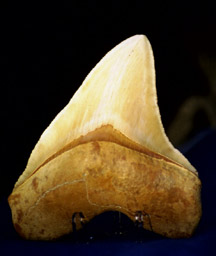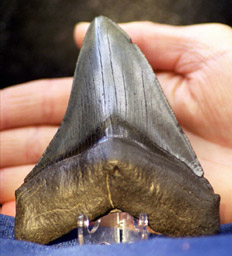|
Home Page
Teeth from St. Mary's River, Georgia
|
|
About Carcharocles megalodon: When you first feel the heft and unimaginable size of a meg tooth, don’t think about the fossil, think about the living animal. A rough estimation of the size of the living fish your tooth came from can be generated by multiplying the size of the tooth you are holding (in inches) times 10 feet per inch…. A 4-inch tooth came from about a 40-ft. shark. Because the shark grew and took extremely large animals for food, the teeth were constantly being shed and replaced from rows of teeth waiting for use. There were 5 rows of teeth each on the top and bottom… 28 teeth per row on top, 30 teeth per row on bottom. In a healthy adult megalodon, there were 290 teeth weighing well over 100 lbs. Sharks’ teeth are “dermal” in origin. They are “genetically glorified” scales, which are not held in deep sockets like the teeth of mammals or even most modern reptiles. Losing teeth was an adaptation that helped megalodon survive the “spirited” battles with large and dangerous “toothed whales” like the sperm whale. The petrified remains of whale bones bearing the marks of sharks’ teeth are a common fossil where megalodon teeth are found. |
||||
 The tooth's final appearance is the product of the elixer of millions of years of biological and geological processes. After your tooth fell to the bottom of the ocean it expanded as it sat in seawater and wet sediment. The larger the tooth, the more the enamel and the root swelled and were stretched by absorbed water. This swelling resulted in the expansion cracks commonly found in the enamel and roots of larger teeth. Over time, the tooth was covered with sediment… and then more sediment until, with the application of heat and pressure; it became part of a sedimentary rock formation. The original components of your tooth were completely replaced by minerals in a process called "permineralization". Your tooth is a minimum of 2 million years old and could be 25 million years old. It was white when it fell from the shark’s mouth. The color it now shows is the product of the invasion of minerals over millions of years… iron minerals result in red colored teeth… the black is from manganese(and other)compounds. |
Megalodon teeth, the final appearance: The final appearance of the tooth is the product of two natural processes; the development of the shark in whose mouth it grew, and the millions of years it took for that tooth to become a “fossil”. While the tooth was in the megalodon’s mouth it may have become damaged when breaking the bones of giant whales and other prey items. These injuries to the tooth are called “feeding damage”. Frequently too, the shark bit his own tooth while it loosened and fell out during feeding frenzies. In these “bite marks” you can see the serrations from the other teeth as they “chomped” down on the enamel of the loose tooth... he bit his own tooth! |
|||
|
Read Definitions and See Photos of Many Terms Used In Describing The Attributes Of Megalodon Teeth On The Tooth Terms Page. |
 |
|||